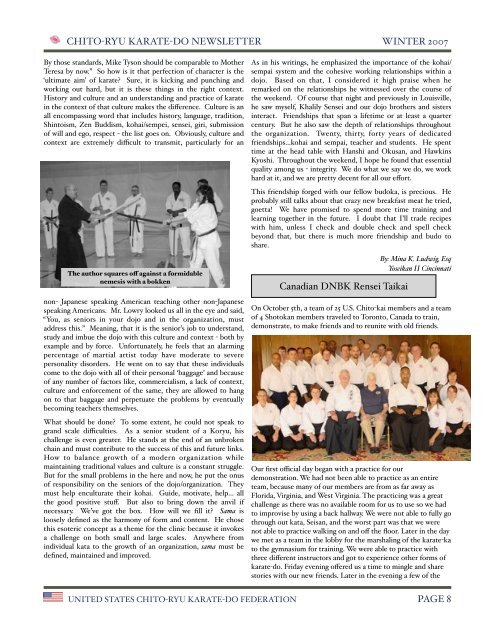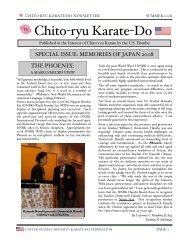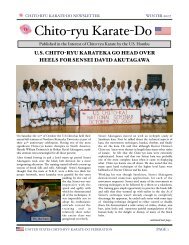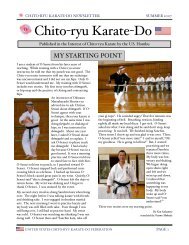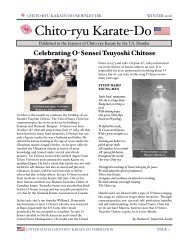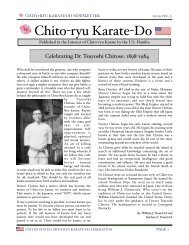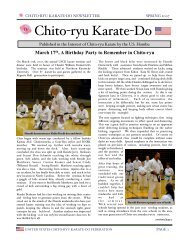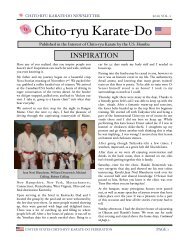spring 2007 - United States Chito-ryu Karate Federation
spring 2007 - United States Chito-ryu Karate Federation
spring 2007 - United States Chito-ryu Karate Federation
Create successful ePaper yourself
Turn your PDF publications into a flip-book with our unique Google optimized e-Paper software.
CHITO-RYU KARATE-DO NEWSLETTER WINTER <strong>2007</strong><br />
By those standards, Mike Tyson should be comparable to Mother<br />
Teresa by now.” So how is it that perfection of character is the<br />
‘ultimate aim’ of karate Sure, it is kicking and punching and<br />
working out hard, but it is these things in the right context.<br />
History and culture and an understanding and practice of karate<br />
in the context of that culture makes the difference. Culture is an<br />
all encompassing word that includes history, language, tradition,<br />
Shintoism, Zen Buddism, kohai/sempei, sensei, giri, submission<br />
of will and ego, respect - the list goes on. Obviously, culture and<br />
context are extremely difficult to transmit, particularly for an<br />
The author squares off against a formidable<br />
nemesis with a bokken<br />
non- Japanese speaking American teaching other non-Japanese<br />
speaking Americans. Mr. Lowry looked us all in the eye and said,<br />
“You, as seniors in your dojo and in the organization, must<br />
address this.” Meaning, that it is the senior’s job to understand,<br />
study and imbue the dojo with this culture and context - both by<br />
example and by force. Unfortunately, he feels that an alarming<br />
percentage of martial artist today have moderate to severe<br />
personality disorders. He went on to say that these individuals<br />
come to the dojo with all of their personal ‘baggage’ and because<br />
of any number of factors like, commercialism, a lack of context,<br />
culture and enforcement of the same, they are allowed to hang<br />
on to that baggage and perpetuate the problems by eventually<br />
becoming teachers themselves.<br />
What should be done To some extent, he could not speak to<br />
grand scale difficulties. As a senior student of a Ko<strong>ryu</strong>, his<br />
challenge is even greater. He stands at the end of an unbroken<br />
chain and must contribute to the success of this and future links.<br />
How to balance growth of a modern organization while<br />
maintaining traditional values and culture is a constant struggle.<br />
But for the small problems in the here and now, he put the onus<br />
of responsibility on the seniors of the dojo/organization. They<br />
must help enculturate their kohai. Guide, motivate, help... all<br />
the good positive stuff. But also to bring down the anvil if<br />
necessary. We’ve got the box. How will we fill it Sama is<br />
loosely defined as the harmony of form and content. He chose<br />
this esoteric concept as a theme for the clinic because it invokes<br />
a challenge on both small and large scales. Anywhere from<br />
individual kata to the growth of an organization, sama must be<br />
defined, maintained and improved.<br />
As in his writings, he emphasized the importance of the kohai/<br />
sempai system and the cohesive working relationships within a<br />
dojo. Based on that, I considered it high praise when he<br />
remarked on the relationships he witnessed over the course of<br />
the weekend. Of course that night and previously in Louisville,<br />
he saw myself, Khalily Sensei and our dojo brothers and sisters<br />
interact. Friendships that span a lifetime or at least a quarter<br />
century. But he also saw the depth of relationships throughout<br />
the organization. Twenty, thirty, forty years of dedicated<br />
friendships...kohai and sempai, teacher and students. He spent<br />
time at the head table with Hanshi and Okusan, and Hawkins<br />
Kyoshi. Throughout the weekend, I hope he found that essential<br />
quality among us - integrity. We do what we say we do, we work<br />
hard at it, and we are pretty decent for all our effort.<br />
This friendship forged with our fellow budoka, is precious. He<br />
probably still talks about that crazy new breakfast meat he tried,<br />
goetta! We have promised to spend more time training and<br />
learning together in the future. I doubt that I’ll trade recipes<br />
with him, unless I check and double check and spell check<br />
beyond that, but there is much more friendship and budo to<br />
share.<br />
Canadian DNBK Rensei Taikai<br />
By: Mina K. Ludwig, Esq<br />
Yoseikan II Cincinnati<br />
On October 5th, a team of 25 U.S. <strong>Chito</strong>-kai members and a team<br />
of 4 Shotokan members traveled to Toronto, Canada to train,<br />
demonstrate, to make friends and to reunite with old friends.<br />
Our first official day began with a practice for our<br />
demonstration. We had not been able to practice as an entire<br />
team, because many of our members are from as far away as<br />
Florida, Virginia, and West Virginia. The practicing was a great<br />
challenge as there was no available room for us to use so we had<br />
to improvise by using a back hallway. We were not able to fully go<br />
through out kata, Seisan, and the worst part was that we were<br />
not able to practice walking on and off the floor. Later in the day<br />
we met as a team in the lobby for the marshaling of the karate-ka<br />
to the gymnasium for training. We were able to practice with<br />
three different instructors and got to experience other forms of<br />
karate-do. Friday evening offered us a time to mingle and share<br />
stories with our new friends. Later in the evening a few of the<br />
UNITED STATES CHITO-RYU KARATE-DO FEDERATION PAGE 8


